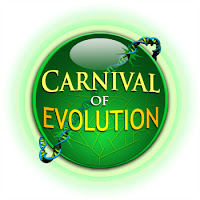Here, in no particular order, are this month's contributions.
M.L. Henneman over at Bioblog by Biotunes nicely parses the debate over invasive species that recently heated up in Nature -- should non-natives be controlled or not, is hating them another form of xenophobia?
Jeremy Fox, at Oikos Blog, explores the issue of trade-offs. Organisms can't be good at everything, and ecologists generally expect to find that organisms do some things very well and some things not so well. He asks whether such trade-offs should in fact be expected in theory.
Over at Lab Rat, on the Scientific American blog site, S.E. Gould writes about the evolution of bacterial energy centres, in particular, the acidocalcisome.
Carl Zimmer, at The Loom, posts some interesting videos that get at the origins of flight. Was wing-flapping useful in its own right before birds could fly? And, PZ Myers at Pharyngula takes on the question of how to reconcile the idea that eyes evolved more than once with the idea that eyes share a common origin.
 |
| Three-spined stickleback Piet Spaans, Wikimedia Commons. |
Kevin Zelnio, dueño of EvoEcoLabs also at Scientific American Blogs, went hunting for good stuff on stickleback fish -- via Google of course. His results were frustratingly thin, prompting him to propose that evolutionary biology needs better PR.
Is it brutal behavior, or just survival? Kelsey, at the Mauka to Makai blog, describes how adult cuckoo and African greater honeyguide females ensure the survival of their offspring, to the detriment of the young of the unknowing host -- complete with video documentation of death and destruction.
Guest blogger Kevin MacCarthy at Scientopia muses about the definition of life. Is it the ability to reproduce? In which case a male and a female together are alive, but one rabbit alone is not?
Over at BioLogos, guest blogger Steve Matheson writes about limbs and common ancestry. And, at Philly.com Faye Flam reports about an investigation of where the nurseryfish fits into the tree of life.
What caused the Black Death? That question has now been answered, and on her blog, Genome Engineering, Suzanne Elvidge gives a nod to the Nature paper that reports that the culprit was indeed Yersinia pestis.
How does variation get shaped toward an adaptive end, when evolution is not goal-directed, Bradly Alicea asks over at Synthetic Daisies. The post is a thoughtful discussion of the question, tying complexity theory with evolutionary theory. Bradly also rediscovers a classic paper by Barbara McClintock in which she discussed different kinds of genomic 'shocks'.
CJ Jenkins discovers evolutionary medicine, over at Nothing In Biology Makes Sense. Devin Drown on the same site writes about the conflict, due to limited resources, that results when two different parasites infect the same host, and how it is resolved. (Thanks to Jeremy Yoder for these submissions.)
And Jeremy Yoder, on his own blog, Denim and Tweed, ponders the possible reasons for the evolution of sexual reproduction. Why share the benefits when reproducing by yourself would double your genetic contribution to the next generation?
At TheViableBlog, Kerstin Hoppenhaus tells us what's in a name. The mite responsible for much honeybee death and destruction wasn't always called Varroa destructor, but when the name fits...
A new phylogeny of mammals was just published in Science. Jerry Coyne at Why Evolution Is True posts the tree and his take on the highlights.
Razib Khan over at Gene Expression says he's now willing to entertain the idea that there may not be a single gene that made us human.
Spanish moss is an example of commensalism, the interaction of organisms in which one benefits and the other is unaffected, at The Phytophactor. And, over at Evolving Thoughts, John Wilkins evolves some thoughts on how organisms are classified and why.
Gemma Atkinson over at Protein Evolution and Other Musings muses about the relationship between hummingbirds and ornithophilous flowers, and the co-evolution of ligands and receptors. She does a nice job morphing hummingbirds into ligands and flowers into receptors.
 And speaking of musing, Ken Weiss, here on the Mermaid's Tale, muses about the concept of uniformitarianism, the idea that while events may be unique, the processes are the same. The idea, which Darwin adopted from geologist Charles Lyell, is central to evolutionary theory, but Ken notes that Marcus Aurelius in 170 AD had much the same thought.
And speaking of musing, Ken Weiss, here on the Mermaid's Tale, muses about the concept of uniformitarianism, the idea that while events may be unique, the processes are the same. The idea, which Darwin adopted from geologist Charles Lyell, is central to evolutionary theory, but Ken notes that Marcus Aurelius in 170 AD had much the same thought.And, Ken offers a different interpretation for the evolution of the hand. For tool use? Nah. He argues that the new fossil finds, of two individuals now called Australopithecus sediba, might better be called Australopithecus erotimanus. Hard to argue with his reasoning. He nicely sums up the sticky issues involved in interpreting these kinds of data here, praising Darwin for his usual circumspection and cautious interpretation.
Next month's Carnival, at The Ocelloid. Submit your entries here.
 |
| Fire breather lending a carnival atmosphere to the Jaipur Maharaja Brass Band in Chassepierre, Belgium. Wikimedia Commons |


2 comments:
Great carnival - have just linked to it on Genome Engineering at http://www.genome-engineering.com/carnival-of-evolution-41-at-the-mermaids-tale.html
Thanks for your list. This is a great collection of current evolution talks, many which I hadn't come across. I also intend to link to it from the blog at the Theatre ZOO.
Post a Comment